Jacobs, William Harvey (Flying Officer)
Killed in Action 1943-November-03
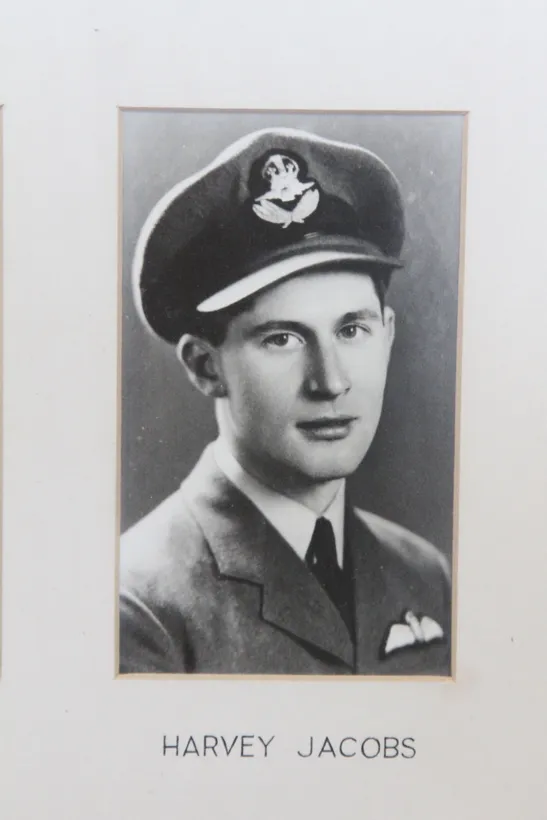

Birth Date: 1919-December-16
Born: Toronto Ontario
Parents: Son of William Henry and Kathleen Jacobs, of Toronto, Ontario.
Spouse:
Home: Toronto, Ontario
Enlistment:
Enlistment Date: unkown date
Service
RCAF
Unit
416 Sqn- Squadron
Ad Saltum Paratus Ready for the leap
Base
Rank
Flying Officer
Position
Pilot
Service Numbers
J/11981
Home
Spitfire serial: BL430
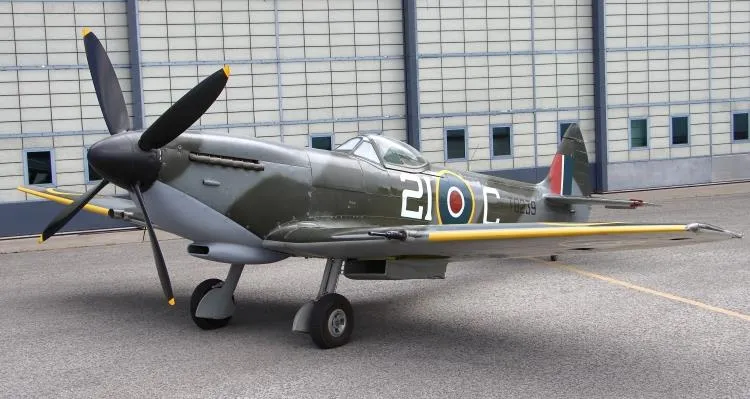
The Supermarine Spitfire is a British single-seat fighter aircraft that was used by the Royal Air Force and other Allied countries before, during, and after World War II. Many variants of the Spitfire were built, using several wing configurations, and it was produced in greater numbers than any other British aircraft. It was also the only British fighter produced continuously throughout the war. The Spitfire continues to be popular among enthusiasts; around 70 remain airworthy, and many more are static exhibits in aviation museums throughout the world.
The Spitfire was designed as a short-range, high-performance interceptor aircraft by R. J. Mitchell, chief designer at Supermarine Aviation Works, which operated as a subsidiary of Vickers-Armstrong from 1928. Mitchell pushed the Spitfire's distinctive elliptical wing with cutting-edge sunken rivets (designed by Beverley Shenstone) to have the thinnest possible cross-section, helping give the aircraft a higher top speed than several contemporary fighters, including the Hawker Hurricane.
The Spitfire had detachable wing tips which were secured by two mounting points at the end of each main wing assembly. When the Spitfire took on a role as a high-altitude fighter (Marks VI and VII and some early Mk VIIIs), the standard wing tips were replaced by extended, "pointed" tips which increased the wingspan from 36 ft 10 in (11.23 m) to 40 ft 2 in (12.24 m). The other wing-tip variation, used by several Spitfire variants, was the "clipped" wing; the standard wing tips were replaced by wooden fairings which reduced the span by 3 ft 6 in (1.07 m). The wing tips used spruce formers for most of the internal structure with a light alloy skin attached using brass screws.
Due to a shortage of Brownings, which had been selected as the new standard rifle calibre machine gun for the RAF in 1934, early Spitfires were fitted with only four guns, with the other four fitted later. Early tests showed that, while the guns worked perfectly on the ground and at low altitudes, they tended to freeze at high altitude, especially the outer wing guns, because the RAF's Brownings had been modified to fire from an open bolt. While this prevented overheating of the cordite used in British ammunition, it allowed cold air to flow through the barrel unhindered. Supermarine did not fix the problem until October 1938, when they added hot air ducts from the rear of the wing-mounted radiators to the guns, and bulkheads around the gunbays to trap the hot air in the wing. Red fabric patches were doped over the gun ports to protect the guns from cold, dirt, and moisture until they were fired.
The first Rolls-Royce Griffon-engined Mk XII flew in August 1942, and first flew operationally with 41 Squadron in April 1943. This mark could nudge 400 mph (640 km/h) in level flight and climb to an altitude of 33,000 ft (10,000 m) in under nine minutes. As American fighters took over the long-range escorting of USAAF daylight bombing raids, the Griffon-engined Spitfires progressively took up the tactical air superiority role, and played a major role in intercepting V-1 flying bombs, while the Merlin-engined variants (mainly the Mk IX and the Packard-engined Mk XVI) were adapted to the fighter-bomber role. Although the later Griffon-engined marks lost some of the favourable handling characteristics of their Merlin-powered predecessors, they could still outmanoeuvre their main German foes and other, later American and British-designed fighters.Wikipedia
![]() Wikipedia Supermarine Spitfire
Wikipedia Supermarine Spitfire
Unit Desciption
416 Sqn Ad Saltum Paratus ("City of Oshawa")
History of the Squadron during World War II (Aircraft: Spitfire Mks. IIA, IIB, VB, VC, IX, IXB, XIVE, XVI)
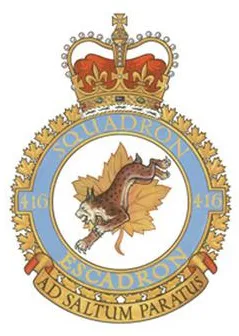
No. 416 Squadron was the 15th RCAF squadron formed overseas in WWII. It was the sixth fighter squadron, and was formed at Peterhead, Scotland ![]() on 22 November 1941. The unit flew Supermarine Spitfire aircraft of various marks as part of the defence of Great Britain, and also undertook offensive operations into Europe. The squadron formed part of the Second Tactical Air Force. After D-Day, the squadron moved to France on June 16, 1944 and thereafter moved with the land forces through France, the Low Countries and Germany, as a fighter and ground attack unit. After the termination of hostilities, the squadron remained in Germany as part of the British Air Forces of Occupation until it was disbanded at Utersen, Germany
on 22 November 1941. The unit flew Supermarine Spitfire aircraft of various marks as part of the defence of Great Britain, and also undertook offensive operations into Europe. The squadron formed part of the Second Tactical Air Force. After D-Day, the squadron moved to France on June 16, 1944 and thereafter moved with the land forces through France, the Low Countries and Germany, as a fighter and ground attack unit. After the termination of hostilities, the squadron remained in Germany as part of the British Air Forces of Occupation until it was disbanded at Utersen, Germany ![]() on 21 March 1946.
on 21 March 1946.
In the course of hostilities, the squadron claimed 75 enemy aircraft destroyed, 3 probables and37 damaged, for the loss of 42 aircraft and 35 pilots, of whom 19 were killed or missing, 13 were POW (1 escapee) and 1 evaded capture. In the ground attack role, the squadron destroyed 286 motor vehicles, 13 locomotives and other miscellaneous targets. Two of the pilots (Flight Lieutenant D.E. Noonan, DFC and Squadron Leader F.H. Boulton, DFC) were aces with at least 5 enemy aircraft shot down. Awards to squadron personnel were 1 Bar to DFC, 11 DFCs, 1 DFM, 1 DFC (USA) and 1 Flying Cross (Netherlands). Battle Honours were: Defence of Britain 1942-44, English Channel and North Sea 1943, Fortress Europe 1942-44, Dieppe, France and Germany 1944-45, Normandy 1944, Arnhem, Rhine.
Maps for Movements of 416 Squadron 1941-46
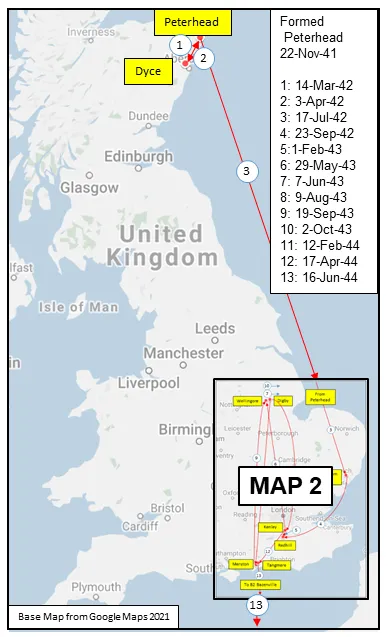
MAP 1: 416 Squadron Movements in Britain 1941-44 (right-click on image to display enlarged in new tab)
|
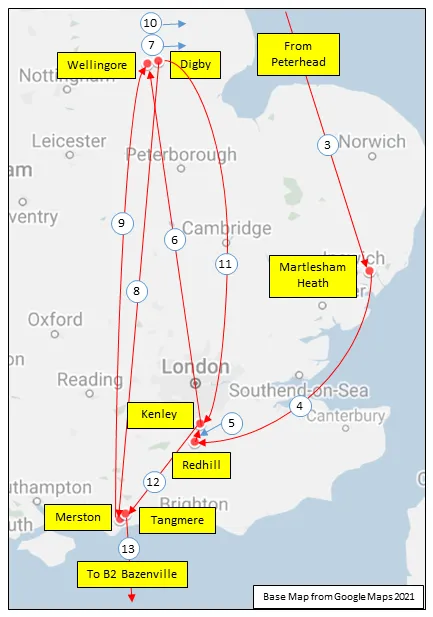
MAP 2: 416 Squadron Movements in Britain: Detail of Map 1
|
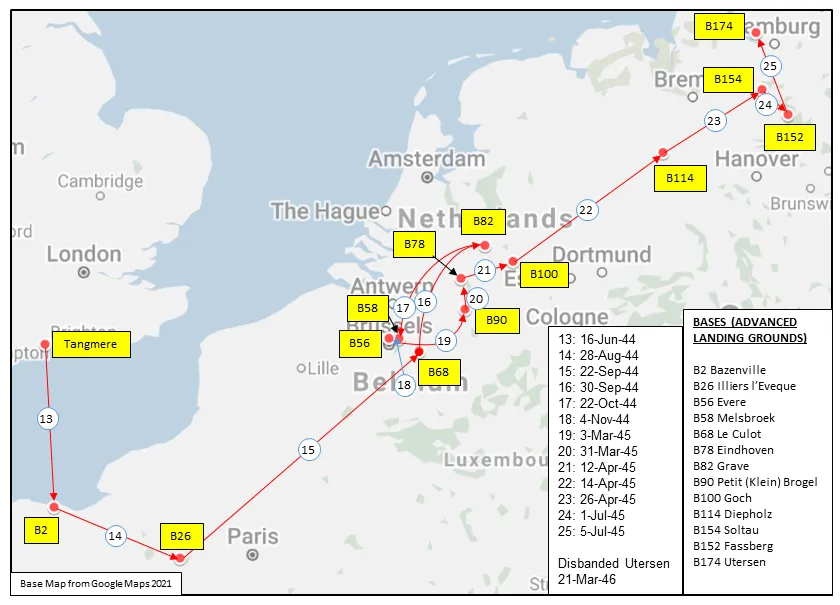
MAP 3: 416 Squadron Movements in Europe 1944-46
|
416 Squadron History Summary 1941-45
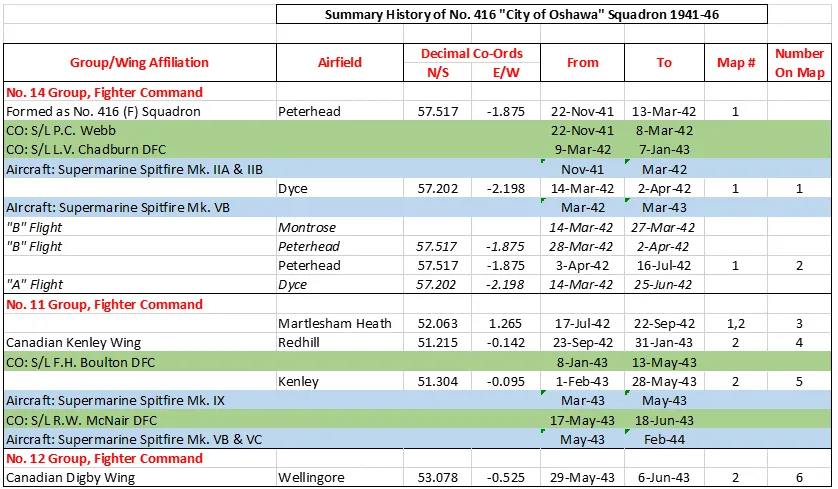
416 Squadron History Summary 1941-45 Page 2
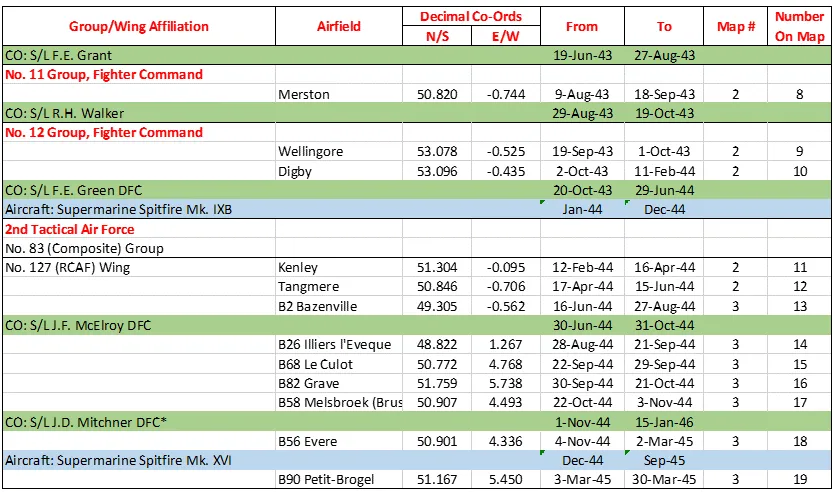
416 Squadron History Summary 1941-45 Page 3

History of the Squadron Post-WWII (Aircraft: Mustang, Sabre Mk 2, 5, 6, Canuck, Voodoo, Hornet)
The squadron was re-formed as a Fighter unit at Uplands, Ontario ![]() on 8 January 1951 with Mustang and, later, Canadair Sabre aircraft of different marks. The squadron joined No. 2 (Fighter) Wing at Grostenquin, France
on 8 January 1951 with Mustang and, later, Canadair Sabre aircraft of different marks. The squadron joined No. 2 (Fighter) Wing at Grostenquin, France ![]() in September 1952. In 1956, it was decided to replace one Sabre squadron in each of No. 1 Air Division Europe’s four wings with an all-weather fighter unit. When No. 423 AW(F) Squadron arrived from Canada, No. 416 was deactivated on 31 January 1957 and reactivated as All-Weather (Fighter) at St Hubert, Quebec
in September 1952. In 1956, it was decided to replace one Sabre squadron in each of No. 1 Air Division Europe’s four wings with an all-weather fighter unit. When No. 423 AW(F) Squadron arrived from Canada, No. 416 was deactivated on 31 January 1957 and reactivated as All-Weather (Fighter) at St Hubert, Quebec ![]() on 1 February, and flew Avro Canada CF-100 (Canuck) aircraft on North American air defence. Pending re-equipment with CF-101 (Voodoo) aircraft, the unit was again deactivated on 1 September 1961. Reactivated at Bagotville, Quebec
on 1 February, and flew Avro Canada CF-100 (Canuck) aircraft on North American air defence. Pending re-equipment with CF-101 (Voodoo) aircraft, the unit was again deactivated on 1 September 1961. Reactivated at Bagotville, Quebec ![]() on 1 January 1962, it subsequently moved to Chatham, New Brunswick
on 1 January 1962, it subsequently moved to Chatham, New Brunswick ![]() in November, where it flew the interceptor until the end of 1984. 416 Squadron thus became the world's last front-line unit flying Voodoos. In 1988 the squadron relocated to CFB Cold Lake as a Tactical Fighter Squadron flying McDonnell-Douglas CF-18s (Hornet), and later merged with 441 Tactical Fighter Squadron to re-form No. 409 Tactical Fighter Squadron in 2006.
in November, where it flew the interceptor until the end of 1984. 416 Squadron thus became the world's last front-line unit flying Voodoos. In 1988 the squadron relocated to CFB Cold Lake as a Tactical Fighter Squadron flying McDonnell-Douglas CF-18s (Hornet), and later merged with 441 Tactical Fighter Squadron to re-form No. 409 Tactical Fighter Squadron in 2006.